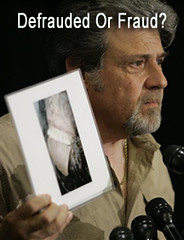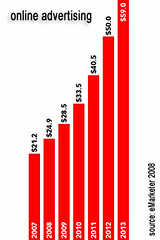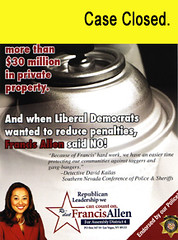So Matt Whitton and his friend Rick Dyer, a former Georgia corrections officer, supposedly chanced onto the remains of Bigfoot and decided to share their story on YouTube. More recently, they held a press conference.
"It's not a human, it's not an ape," Whitton, a Georgia police officer, told the media.
Whitton was right about that. It wasn’t human or an ape, but a rubber suit designed to drive traffic to their Web site and, presumably, to an online store where you can purchase a shirt or spend upwards of $5,000 (currently) to be taken to the site where they found, er, planted their phony evidence.
The Bigfoot hunters are probably not laughing now. The police department intends to fire Whitton; they will likely be charged with fraud; and the messages filling up their guest book are less than sympathetic.
While Whitton and Dyer reportedly admitted it to be a hoax after being confronted, they have since fled. And most people, it seems, consider Tom Biscardi, who was allegedly defrauded for $50,000 or more, in on the hoax.
Perhaps most disappointed of all was Jeffrey Turner, chief of police in Clayton County, Georgia. He had granted Whitton medical leave after the officer was shot while attempting to stop a robbery.
“This turn of events from hero to someone who defrauds a nation is just baffling. I don’t know how he got from one point to the other,” Turner told the reporters. “For someone to do a complete three-sixty like that, I can't explain it."
Hmmm … maybe those Bigfoot hunters were led to believe that “all publicity is good publicity.”

"It's not a human, it's not an ape," Whitton, a Georgia police officer, told the media.
Whitton was right about that. It wasn’t human or an ape, but a rubber suit designed to drive traffic to their Web site and, presumably, to an online store where you can purchase a shirt or spend upwards of $5,000 (currently) to be taken to the site where they found, er, planted their phony evidence.
The Bigfoot hunters are probably not laughing now. The police department intends to fire Whitton; they will likely be charged with fraud; and the messages filling up their guest book are less than sympathetic.
While Whitton and Dyer reportedly admitted it to be a hoax after being confronted, they have since fled. And most people, it seems, consider Tom Biscardi, who was allegedly defrauded for $50,000 or more, in on the hoax.
Perhaps most disappointed of all was Jeffrey Turner, chief of police in Clayton County, Georgia. He had granted Whitton medical leave after the officer was shot while attempting to stop a robbery.
“This turn of events from hero to someone who defrauds a nation is just baffling. I don’t know how he got from one point to the other,” Turner told the reporters. “For someone to do a complete three-sixty like that, I can't explain it."
Hmmm … maybe those Bigfoot hunters were led to believe that “all publicity is good publicity.”






















